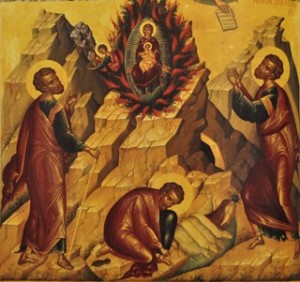Our Creed

“Who for us and for our salvation, came down from Heaven, and was incarnate of the Holy Spirit and the Virgin Mary and became human”
The concluding phrase of the third article of our Creed, “and became human”, contains profound theological depth and far-reaching consequences for our salvation. The attempt to define who Christ is proved to be the greatest point of contention for the Church over many centuries, forming the focal point of many Ecumenical Councils. To this day, the Person of our Lord Jesus Christ ‘provokes’ every person of faith to consider their own human nature and spiritual potential as children of God.
The Fourth Ecumenical Council, held at Chalcedon in 451, declared in its famous Definition of Faith that the Lord Jesus Christ is to be confessed as “…one and the same Son, the same perfect in divinity and perfect in humanity, the same truly God and truly man, of a rational soul and a body; of one essence with the Father as regards His divinity, and the same of one essence with us as regards His humanity; like us in all respects except for sin…”
The same Church fathers described the union of the two natures in the unique Person of Christ as being: “without confusion, without change, without division, without separation.” The various Christological heresies tended to emphasise either the divine or the human nature in Christ, at the expense of the other. This had drastic soteriological consequences for man. St Gregory the Theologian, at pains to defend that the Son of God assumed our human nature in its fullness (flesh and soul), impressively declares: “What is not assumed, is not healed, and what is united to God is saved.”
The “hypostatic union” of the divine and human natures in Christ (ie. their union in the single divine hypostasis of the Son of God), has significant consequences. One of these is the so-called “communication of attributes” which refers to the unique reciprocity taking place between the two natures in the Person of Christ – where the one shares their attributes with the other.
Why is this important?
Through this “communication of attributes” Christ’s assumed human nature is exalted, perfected and deified by His divine nature, without ceasing to remain created and human, just as His divine nature remains uncreated and divine. As His human nature (coming from the womb of the Virgin Mary), is our human nature, herein lies the magnificent mystery of the healing of our sick nature, which fell ill from the fall. Through the intimate hypostatic union of the two natures in Himself, Christ pours divinity into all of human nature.
We are each called to share personally in this healing offered to us by Christ. How? Through communion with Him. For example, we are united with Christ by grace when we venerate the Holy Gospel, icons, relics; when we pray, and when we participate in the liturgical worship of the Church. The ultimate participation in Christ occurs through the Mystery of the Holy Eucharist, in which we partake of His deified body and blood of and become “partakers of the divine nature” (2 Pet. 1:4).
The Evangelist John poignantly confesses: “That which was from the beginning, which we have heard, which we have seen with our eyes, which we have looked upon, and our hands have handled, concerning the Word of life…” (1 John 1:1). The Son of God united with our human nature in order to come and dwell among us – as one of us – in a historical time and place, to teach us, and ultimately to heal and restore us. What magnificent condescension! Glory be to God.
The next edition on “Our Creed” will focus on the last phrase of Article 3: “and became human”
Source: Lychnos August-September 2021
